When you think about enhancing your Harley Softail's safety and performance, the importance of selecting the right brake pads can't be overstated. Not only do the best pads improve your stopping power, but they also contribute to a smoother ride. Whether you prefer semi-metallic, carbon fiber, or organic options, each type offers distinct advantages tailored to your needs. But how do you know which ones are the best fit for your Softail? Let's explore the top five brake pads that could transform your riding experience.
Quick Takeaways
- Material Selection: Opt for semi-metallic pads for high-performance braking or carbon fiber pads for lightweight efficiency and reduced dust production.
- Model-Specific Fit: Ensure brake pads are compatible with your Harley Softail model for optimal performance and safety.
- Durability and Longevity: Choose pads with heat dissipation features to enhance durability and reduce wear over time, ensuring consistent performance.
- Installation Ease: Most brake pads are straightforward to install, but consult guides for your specific model to avoid complications.
- Cost vs. Performance: Balance your budget with the benefits of higher-quality pads, which may offer better heat resistance and longevity.
Cyleto Front & Rear Brake Pads for Harley Davidson Softail and Dyna Models
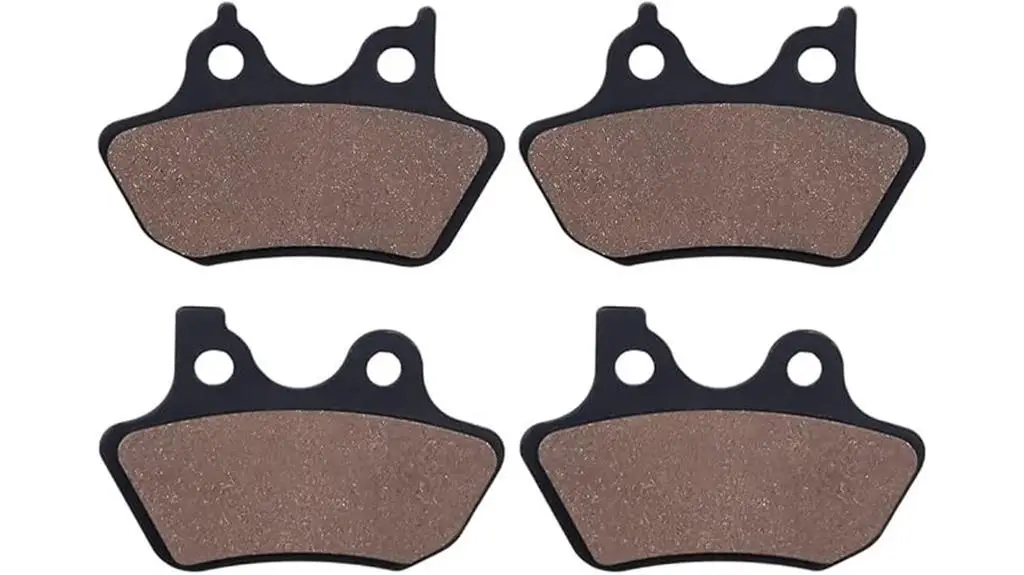
The Cyleto Front & Rear Brake Pads are an excellent choice for Harley Davidson Softail and Dyna models, delivering enhanced braking performance for riders seeking reliability on the road. Crafted from carbon fiber, these pads provide impressive stopping power, making them compatible with various models, including the FLSTCI and FXSTB Night Train. Weighing just 1.11 pounds and measuring 3.84 x 2.53 x 0.31 inches, they're easy to handle during installation. Users generally find the installation straightforward, although some mention needing additional parts like anti-rattle clips. With a solid rating of 4.3 out of 5 stars, feedback highlights their improved performance over original pads, though concerns about manufacturing quality and missing components persist. Overall, they're a reliable option for enhancing safety.
Best For: Riders of Harley Davidson Softail and Dyna models seeking enhanced braking performance and reliability on the road.
Pros:
- Improved stopping power compared to original brake pads.
- Generally easy installation with a lightweight design.
- Compatible with a variety of Harley Davidson models.
Cons:
- Some concerns regarding manufacturing quality and alignment issues.
- Missing components such as anti-rattle clips and lube reported by users.
- Long-term durability remains untested by many customers.
Front and Rear Brake Pads for Harley Davidson Softail and Touring Models
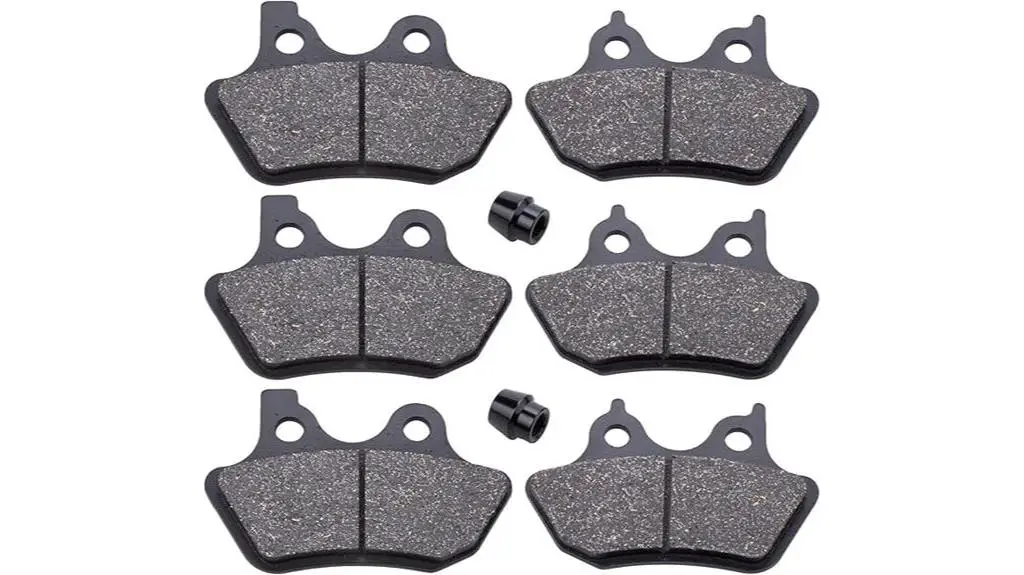
For riders seeking reliable performance and durability, MWMNUN Front and Rear Brake Pads stand out as an exceptional choice for Harley Davidson Softail and Touring models. Crafted from semi-metallic materials, these brake pads guarantee high-temperature resistance and stable friction performance, making them ideal for various riding conditions. With dimensions of 97.54 x 64.2 x 7.5 mm and a weight of 1.67 pounds, they offer strong braking force while maintaining a low wear rate. Customers appreciate their low dust production and excellent resistance to heat and water corrosion. Rated 4.7 out of 5 stars, these pads come as three pairs, along with two universal air nozzle caps. MWMNUN provides professional support, assuring satisfaction with every ride.
Best For: Riders of Harley Davidson Softail and Touring models seeking high-performance, durable brake pads for various riding conditions.
Pros:
- High-temperature resistance ensures stable friction performance.
- Low dust production contributes to cleaner wheels and longer intervals between cleaning.
- Long service life with a very low wear rate, providing excellent value for money.
Cons:
- Limited compatibility as they are specifically designed for certain Harley Davidson models.
- Imported product may not appeal to those preferring domestically manufactured parts.
- Warranty details are not explicitly provided, requiring customers to check the product page for specifics.
Front & Rear Brake Pads for Harley Davidson Softail and Sportster (1988-1999)
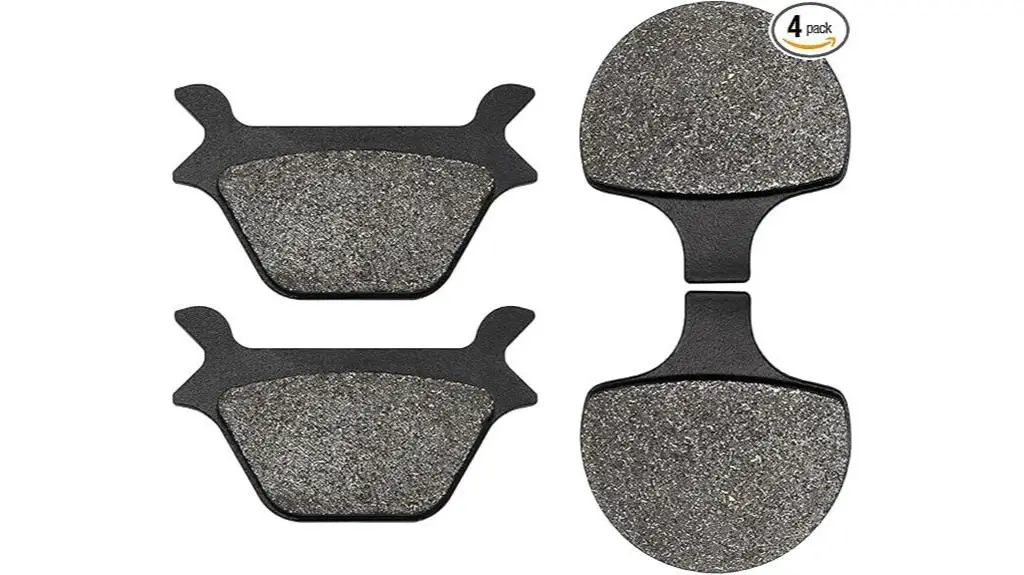
Riders seeking reliable performance and durability will find the Front & Rear Brake Pads for Harley Davidson Softail and Sportster (1988-1999) an excellent choice. Manufactured by ZICOO, these semi-metallic brake pads are designed for various Harley models, including the Softail Custom and Sportster 1200. Each package includes four pieces, ensuring both front and rear axles are covered. These pads meet or exceed OEM quality standards, providing high toughness and temperature resistance. The innovative groove design enhances heat dissipation and minimizes noise, making them ideal for harsh riding conditions. With a solid customer rating of 4.3 out of 5 stars, these brake pads promise to enhance safety and performance on the road.
Best For: Riders of Harley Davidson Softail and Sportster models from 1988 to 1999 seeking high-quality and reliable brake pads for improved safety and performance.
Pros:
- Meets or exceeds OEM quality standards, ensuring reliability and durability.
- Innovative groove design enhances heat dissipation and reduces noise.
- Compatible with a wide range of Harley models, making it versatile for owners.
Cons:
- Limited to specific Harley models from 1988 to 1999, not suitable for newer models.
- Semi-metallic material may produce more dust compared to other options.
- Some users may prefer organic pads for reduced wear on rotors.
Front and Rear Brake Pads for Harley Davidson Motorcycles
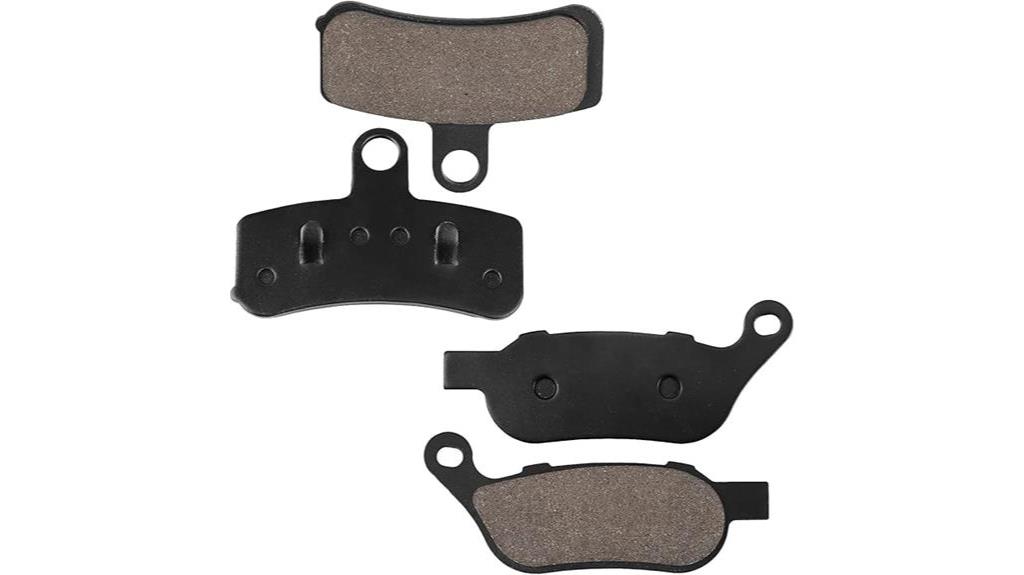
Offering compatibility with a wide range of Harley Davidson models, these brake pads are an ideal choice for motorcycle enthusiasts seeking reliable performance. Designed for various models like the Fatboy, Heritage Softail Classic, and Street Bob, they measure 90.6 x 62.1 x 8.1mm for the front and 130 x 56.5 x 8mm for the rear. Weighing just 1.08 pounds, these aluminum pads guarantee a quiet braking experience while extending brake life. Their standard slotting and shimming enhance dynamic braking performance, and installation is quick and straightforward. While customer feedback highlights easy installation and decent performance, some users report issues with fit and dust production. With a solid warranty and customer service, these brake pads provide an attractive option for Harley riders.
Best For: Motorcycle enthusiasts looking for reliable and well-performing brake pads compatible with a variety of Harley Davidson models.
Pros:
- High-quality aluminum construction ensures a quiet braking experience.
- Easy and quick installation process for hassle-free setup.
- Extends brake life, making them suitable for daily use.
Cons:
- Some users report issues with fit and compatibility.
- Dust production has been noted by several customers.
- Mixed feedback on performance, with concerns about potential misengineering.
Brake Pads for Harley-Davidson Motorcycles (1988-1999)
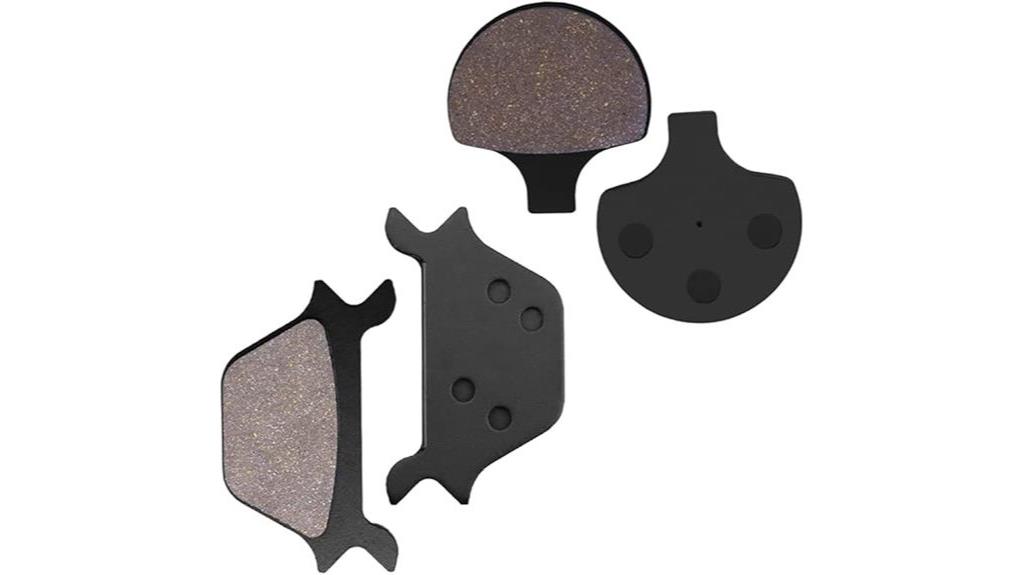
Harley-Davidson enthusiasts looking for reliable brake pads for their 1988-1999 models will find the LOCOPOW brake pads to be an excellent choice. Designed for models like the Fatboy and Sportster, these semi-metal, non-asbestos pads incorporate brass for enhanced performance. With high temperature resistance and a low wear rate, they promise longevity and stability in various conditions. Their unique design features grooves and chamfered surfaces to minimize noise while improving adhesion. Weighing 1.46 pounds and measuring 7.44 x 5.91 x 1.34 inches, these pads are easy to handle. Rated 4.5 out of 5 stars, they come with a 30-day return guarantee, ensuring customer satisfaction. However, some users have reported compatibility issues, so careful selection is advised.
Best For: Harley-Davidson motorcycle owners from 1988 to 1999 looking for high-performance, reliable brake pads that enhance safety and comfort.
Pros:
- High temperature resistance and stable friction performance for reliable braking.
- Grooved and chamfered design minimizes noise and improves adhesion.
- Long service life with low wear rate and reduced dust emissions for environmental protection.
Cons:
- Some users report compatibility issues that may lead to rotor damage.
- Mixed customer feedback regarding fit and performance.
- Limited warranty information available, requiring inquiry for details.
Factors to Consider When Choosing Brake Pads for Harley Softail
When you're choosing brake pads for your Harley Softail, several key factors come into play. You'll want to evaluate the material quality, compatibility with your specific model, and how easy installation is. Additionally, think about performance in different riding conditions and the longevity of the pads for your riding style.
Material Quality and Composition
Considering the various riding conditions and personal preferences, selecting the right brake pads for your Harley Softail hinges on material quality and composition. Brake pads are typically made from semi-metallic, carbon fiber, or organic compounds, each impacting performance and durability differently.
Semi-metallic pads offer strong braking force and high wear resistance, making them a solid choice for high-performance riding. If you prefer something lighter with consistent performance, carbon fiber pads are worth considering. They produce less dust and maintain their braking effectiveness over time.
Sound can also play a role in your choice. Grooved or chamfered designs help reduce noise, enhancing comfort during your rides. You'll want to pay attention to heat resistance too. High temperatures can lead to brake fade, resulting in decreased performance. Choosing pads that can effectively dissipate heat is essential for maintaining braking efficiency.
Ultimately, the material quality and composition of your brake pads should align with your riding style and conditions. By understanding these factors, you can make an informed decision to enhance both the safety and performance of your Harley Softail.
Compatibility With Models
Finding the right brake pads for your Softail involves confirming they match your specific model, like the FLSTCI or Fat Boy. Each Harley model has unique specifications, so you'll want to verify compatibility. Many brake pads are designed for a range of models, but that doesn't mean they're universally applicable. For instance, some may fit the Sportster XLH883R or FXST Softail Standard, while others don't.
Material type also plays a significant role in compatibility and performance. Brake pads made from carbon fiber or semi-metallic materials can behave differently, affecting your bike's braking performance. Make certain you understand these materials to choose the best option for your riding style.
Moreover, it's essential to check if the brake pads meet or exceed OEM quality standards. This guarantees they'll perform well on your specific Softail series. Finally, keep in mind that installation might require additional parts or modifications, depending on your model year. Always verify fitment details before making a purchase. This way, you won't face surprises during installation, and you'll guarantee a safer ride on your Harley.
Installation Complexity
Installing brake pads on your Harley Softail can be straightforward, but several factors can influence the complexity of the process. Generally, users find the installation easy, but you might need extra parts like anti-rattle clips and lube for a complete job. Some brake pad models, however, may present alignment issues, complicating the installation and leading to inconsistent fit and performance.
The complexity often varies based on your specific Softail model year and the type of brake pads you choose. Different variants may require different approaches, so pay close attention to compatibility. While some brake pads come with all necessary components, others might lack essential parts, which can increase the difficulty of installation.
If you're unfamiliar with motorcycle maintenance, it's wise to consult installation guides or seek professional help to guarantee a proper and safe installation. Taking these factors into account can save you time and frustration, guaranteeing your ride remains safe and enjoyable. So, before diving in, make sure you're fully prepared for the task ahead.
Performance in Various Conditions
When it comes to choosing brake pads for your Harley Softail, performance in various conditions is a key factor to keep in mind. If you often ride in high-temperature environments, consider semi-metallic brake pads. They provide stable friction and enhanced stopping power, essential for safety. On the other hand, if you prioritize lightweight options, carbon fiber pads might suit your needs, though their long-term durability isn't as well established.
Pay attention to the design of the brake pads, too. Features like grooves and chamfered surfaces can greatly reduce noise and enhance comfort, especially when braking in harsh conditions. If you're concerned about the environment, look for low-wear formulas that minimize dust emissions while extending the life of the pads during daily use.
Lastly, consider brake pads that exhibit high resistance to heat and water corrosion. These will perform better across diverse terrains, whether you're traversing sandy trails or muddy roads. By taking these factors into account, you can choose brake pads that not only enhance your ride's safety but also optimize your performance in various riding conditions.
Longevity and Durability
Longevity and durability are crucial factors to take into account when selecting brake pads for your Harley Softail. The material composition plays a significant role, with semi-metallic and carbon fiber options offering different levels of durability and wear rates. You'll want high-quality brake pads designed to withstand high temperatures, as stable friction performance in demanding conditions can lead to a longer service life.
Look for features like grooves in the brake pads, which enhance heat dissipation and reduce wear. These design elements can contribute to extending the lifespan of your pads. It's also crucial to evaluate the wear rate; materials with lower wear rates will decrease the frequency of replacements, improving your bike's overall performance and saving you time and money.
Additionally, keep in mind that environmental factors, like exposure to water and corrosion, can impact the durability of your brake pads. Choosing pads with excellent resistance to these conditions will further increase their longevity. By prioritizing these aspects, you can guarantee that your Harley Softail remains safe and performs at its best for years to come.
Environmental Considerations
Choosing the right brake pads for your Harley Softail goes beyond just durability; environmental considerations play a significant role in your decision. When selecting brake pads, you should look for options made from environmentally friendly materials like semi-metallic or non-asbestos compounds. These types typically produce lower dust emissions, contributing to cleaner air.
Also, consider brake pads that utilize low-wear formulas. They not only extend the lifespan of your pads but also reduce the frequency of replacements, minimizing the environmental impact associated with manufacturing and disposal. Pads featuring excellent heat and water resistance perform reliably in various conditions, further decreasing wear and reducing the need for replacements.
Additionally, designs with grooves and chamfered surfaces can enhance noise reduction and improve adhesion. This not only promotes a quieter ride but also reduces stress on brake components, boosting overall efficiency. Finally, seek out products crafted with sustainable production practices, such as corrosion-resistant materials. These features contribute to the longevity of your brake pads, ultimately reducing waste and your environmental footprint throughout their lifecycle. Prioritizing these factors makes your ride safer and more eco-friendly.
Price and Value Comparison
Finding the right brake pads for your Harley Softail involves more than just picking the first option you see; it's essential to weigh the price against the value you'll get. Typically, you'll find that semi-metallic pads are more affordable than carbon fiber alternatives, but don't let price alone guide your decision.
Consider how the cost reflects performance. Higher-priced brake pads often offer benefits like better heat resistance, lower dust production, and longer service life. While they may seem like a bigger upfront investment, they could save you money in the long run by reducing the frequency of replacements.
Also, look for packages that include extra components, like universal air nozzle caps, as they can add significant value. Customer ratings are another useful tool; higher-rated products often justify their price through superior durability and user satisfaction.
Common Questions
How Do I Know When to Replace My Brake Pads?
You'll know it's time to replace your brake pads when you hear squeaking or grinding noises while braking, or if you notice a decrease in braking performance. Additionally, check for a warning light on your dashboard, or inspect the pads visually. If they're less than a quarter-inch thick, it's definitely time for a replacement. Regularly checking them can help guarantee your safety and maintain your vehicle's performance.
Are Aftermarket Brake Pads Better Than OEM Options?
Imagine your bike as a trusty steed, galloping through winding roads. When it comes to brake pads, aftermarket options often shine brighter than OEM ones. They can provide enhanced performance and durability, like a well-trained horse that knows every curve. However, you'll want to research brands and read reviews to guarantee quality. Ultimately, it's about how they fit your riding style and how confident you feel when you pull those brakes.
Can I Mix Different Brands of Brake Pads?
You can mix different brands of brake pads, but it's not always recommended. Each brand uses different materials and compounds, which can lead to uneven wear or inconsistent braking performance. If you decide to mix them, make certain they're compatible regarding friction levels and heat resistance. It's usually best to stick with one brand for both front and rear pads to guarantee peak safety and performance while riding.
What Tools Do I Need to Install Brake Pads?
Did you know that 70% of motorcycle accidents involve brake failure? To install brake pads, you'll need a few essential tools. Grab a socket wrench set, brake caliper tool, and a torque wrench for proper tightening. Don't forget a flathead screwdriver for prying and possibly pliers to remove any stubborn clips. Having a clean workspace and some brake cleaner handy will make the job easier and safer, ensuring your ride's ready for the road.
Do Brake Pads Affect My Motorcycle's Warranty?
Yes, brake pads can affect your motorcycle's warranty, but it often depends on the manufacturer's policy. If you use aftermarket pads, some warranties might be voided if those parts cause damage. To stay safe, always check your warranty terms and consider using OEM parts. If you're unsure, consult your dealer or the manufacturer directly to avoid any potential issues. Keeping everything within warranty guidelines guarantees your ride remains protected.
Wrapping Up
Upgrading your Harley Softail's brake pads isn't just about performance—it's about your safety on the road. Choosing the right pads can make all the difference, giving you confidence in every ride. Imagine the peace of mind knowing you've invested in high-quality components that enhance your stopping power. Don't leave your safety to chance; trust in the best options available. Your ride deserves it, and so do you. Enjoy every mile with the assurance of reliable braking performance.